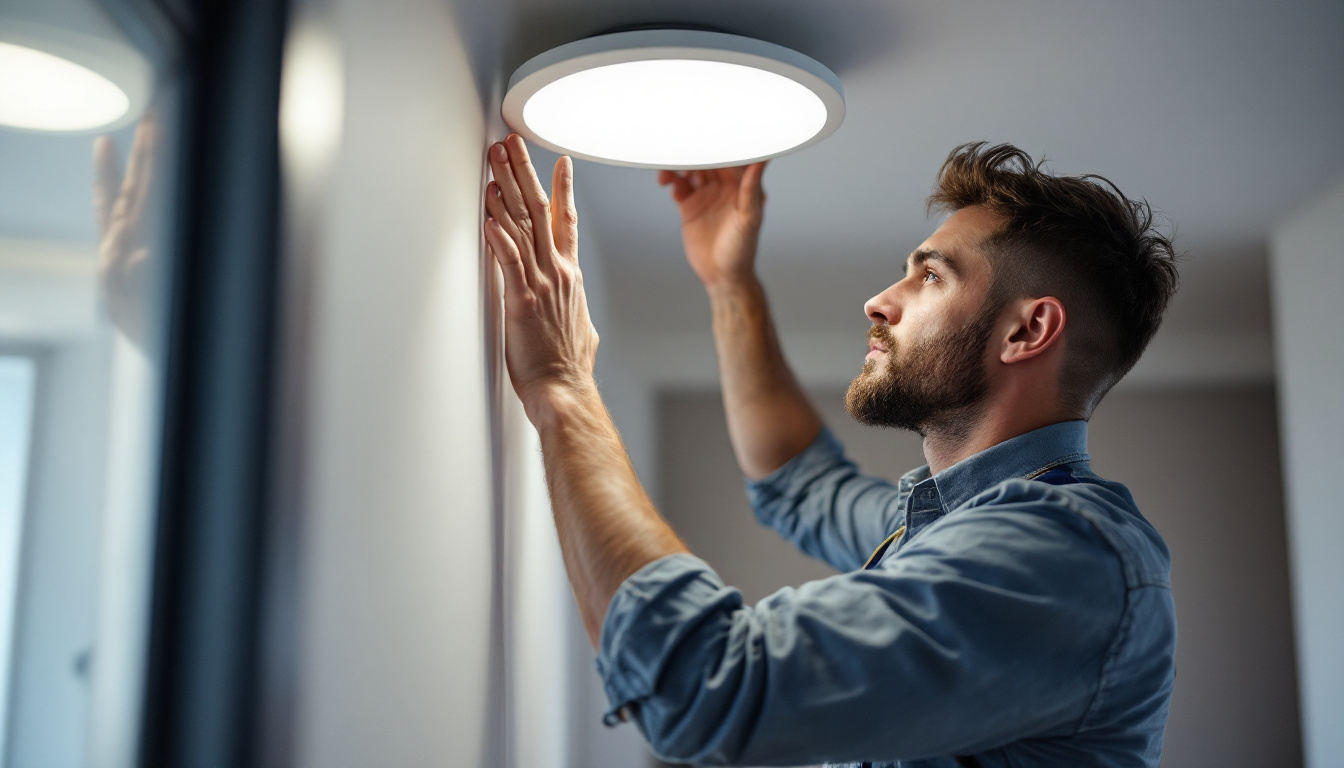
lighting contractors play a crucial role in the industrial sector, ensuring that spaces are not only illuminated but also optimized for functionality and safety. Mastering the art of industrial lighting involves understanding various factors, including technology, design principles, and client needs. This article aims to provide essential tips that can elevate the work of lighting contractors and enhance their project outcomes.
Before diving into advanced techniques, it is vital for lighting contractors to grasp the fundamental concepts of industrial lighting. This foundational knowledge can significantly impact the quality and effectiveness of lighting solutions.
Industrial lighting can be categorized into several types, each serving a unique purpose. Common types include ambient lighting, task lighting, and accent lighting. Ambient lighting provides general illumination, ensuring that spaces are well-lit for overall visibility. Task lighting, on the other hand, focuses on specific areas where detailed work is performed, such as assembly lines or inspection stations. Accent lighting is used to highlight particular features or areas, adding aesthetic value to the industrial environment.
Understanding these categories allows lighting contractors to tailor their designs to meet specific needs, ensuring that every area is appropriately illuminated.
The evolution of lighting technologies has transformed the industrial landscape. Familiarity with various technologies, such as LED, fluorescent, and high-intensity discharge (HID) lights, is essential. LEDs are known for their energy efficiency and longevity, making them a popular choice for many industrial applications. Fluorescent lights, while less efficient than LEDs, are still widely used due to their cost-effectiveness. HID lights are typically employed in larger spaces, providing high-intensity illumination.
By understanding the strengths and weaknesses of each technology, contractors can make informed decisions that align with their clients’ goals and budgets.
Compliance with local, national, and international lighting standards is non-negotiable. Regulations such as the Occupational Safety and Health Administration (OSHA) guidelines and the Illuminating Engineering Society (IES) recommendations provide frameworks for safe and effective lighting. Contractors must stay informed about these regulations to ensure that their designs not only meet aesthetic and functional requirements but also adhere to safety standards.
Failure to comply can lead to legal repercussions and compromise the safety of workers, making it essential for contractors to prioritize regulatory knowledge.
Once the basics are understood, the next step is applying design principles that enhance the effectiveness of lighting solutions. Good design not only improves visibility but also contributes to the overall productivity and safety of the workspace.
A thorough assessment of the space is the cornerstone of effective lighting design. This involves evaluating the layout, the tasks performed, and the specific needs of the workers. Each industrial environment is unique, and what works in one facility may not be suitable for another. Factors such as ceiling height, surface colors, and the presence of machinery can all influence lighting decisions.
Contractors should conduct site visits and engage with clients to gather insights about the operational needs and challenges faced in the space. This collaborative approach ensures that the final design is tailored to the specific context.
Utilizing a layered lighting approach can significantly enhance the functionality of industrial spaces. This technique involves combining different types of lighting—ambient, task, and accent—to create a well-balanced environment. For instance, ambient lighting can provide a general glow, while task lighting can be strategically placed over workstations to facilitate detailed tasks.
This method not only improves visibility but also reduces eye strain and enhances worker comfort, ultimately leading to increased productivity. Contractors should consider the interplay between different lighting types and how they can be harmonized within the space.
The color temperature of lighting plays a crucial role in influencing mood and productivity. Cooler color temperatures (5000K to 6500K) are often associated with alertness and are ideal for environments where focus is essential. Warmer temperatures (2700K to 3000K) can create a more relaxed atmosphere, which may be suitable for break areas.
In addition to color temperature, the quality of light, including factors such as color rendering index (CRI), should be considered. High CRI values (90 and above) ensure that colors appear more vibrant and true to life, which is particularly important in environments where color differentiation is critical.
As industries increasingly focus on sustainability, lighting contractors must prioritize energy-efficient solutions. Not only do these solutions help reduce operational costs, but they also contribute to environmental conservation.
smart lighting technologies, such as occupancy sensors and dimmers, can significantly enhance energy efficiency. These systems automatically adjust lighting based on occupancy and natural light levels, ensuring that energy is not wasted. For instance, lights can be programmed to dim or turn off when areas are unoccupied, leading to substantial energy savings over time.
Contractors should explore integrating smart technologies into their designs, providing clients with modern solutions that align with sustainability goals.
When selecting lighting fixtures, opting for energy-efficient models is crucial. LED fixtures, for example, consume significantly less energy than traditional incandescent or fluorescent lights. Additionally, they have a longer lifespan, reducing the frequency of replacements and associated waste.
Contractors should stay updated on the latest energy-efficient products and technologies, as advancements in this area are continually evolving. Providing clients with options that prioritize efficiency can enhance their overall satisfaction and contribute to a greener future.
Proper disposal and recycling of old lighting products are essential components of sustainable practices. Many lighting fixtures contain hazardous materials, such as mercury in fluorescent bulbs, which require special handling to prevent environmental contamination. Contractors should educate clients about responsible disposal methods and encourage recycling programs.
By promoting sustainable practices throughout the lifecycle of lighting products, contractors can reinforce their commitment to environmental stewardship.
Effective communication and project management are vital for the success of any lighting project. Lighting contractors must navigate client expectations, timelines, and budgets while ensuring that the final product meets the desired outcomes.
From the outset, clear communication with clients is essential. This involves discussing project goals, timelines, and budget constraints. Contractors should provide detailed proposals that outline the scope of work, including design concepts, fixture selections, and installation processes.
By setting realistic expectations, contractors can minimize misunderstandings and create a collaborative environment where clients feel informed and engaged throughout the project.
Maintaining regular communication during the project is crucial for ensuring that everything stays on track. Providing clients with updates on progress and any potential challenges fosters trust and transparency. Additionally, establishing feedback loops allows clients to share their thoughts and preferences, enabling contractors to make adjustments as needed.
This iterative approach not only enhances client satisfaction but also leads to a more successful outcome, as contractors can address concerns promptly and effectively.
Once the installation is complete, the relationship between the contractor and client should not end. Offering post-installation support, including maintenance services and troubleshooting, can significantly enhance client satisfaction. Providing clients with guidance on how to operate and maintain their lighting systems ensures that they continue to function optimally.
Additionally, this ongoing support can lead to repeat business and referrals, as satisfied clients are more likely to recommend contractors who provide exceptional service beyond the initial project.
The lighting industry is constantly evolving, with new technologies and design trends emerging regularly. For lighting contractors to remain competitive, ongoing education and professional development are essential.
Contractors should actively seek out opportunities to stay informed about the latest industry trends, technologies, and best practices. This can involve attending trade shows, participating in webinars, and subscribing to industry publications. Engaging with professional organizations can also provide valuable resources and networking opportunities.
By staying informed, contractors can offer clients cutting-edge solutions that meet their evolving needs and preferences.
Investing in certifications and training programs can enhance a contractor’s credibility and expertise. Many organizations offer specialized training in areas such as energy efficiency, lighting design, and smart technologies. Obtaining certifications not only demonstrates a commitment to professional development but also provides clients with confidence in the contractor’s skills and knowledge.
Contractors should consider pursuing relevant certifications to differentiate themselves in a competitive market and enhance their service offerings.
Building a network of peers within the industry can provide valuable insights and support. Networking allows contractors to share experiences, discuss challenges, and learn from one another. Engaging with fellow professionals can lead to collaborations, partnerships, and referrals, ultimately benefiting all parties involved.
Participating in industry events, forums, and online communities can help contractors expand their networks and stay connected with the latest developments in the field.
Mastering industrial lighting requires a combination of technical knowledge, design principles, and effective communication. By understanding the basics, applying sound design strategies, prioritizing energy efficiency, and maintaining strong client relationships, lighting contractors can elevate their work and deliver exceptional results.
As the industry continues to evolve, staying informed and committed to professional development will be key to success. By embracing these tips and best practices, lighting contractors can not only meet but exceed client expectations, ensuring that their projects shine brightly in the industrial landscape.
Ready to take your lighting projects to the next level? At LumenWholesale, we provide lighting contractors with the high-quality, spec-grade lighting products you need to excel. With unbeatable wholesale prices and a commitment to cutting out the middleman, we ensure you get the best value for your investment. Our extensive selection not only meets but exceeds industry standards, guaranteeing reliable and high-performance lighting for every industrial application. Plus, with the convenience of free shipping on bulk orders, you can enjoy premium lighting solutions without hidden fees or compromises. Elevate your lighting game and experience wholesale lighting at the best value today with LumenWholesale.

Discover essential tips for lighting contractors to seamlessly integrate backyard solar lamps into their projects.

Discover the essentials of electrical cords tailored for lighting contractors.

Explore the innovative strategies employed by smart lighting contractors in “Led Recessed 6.” Discover cutting-edge techniques and technologies that are revolutionizing the world of recessed lighting, enhancing efficiency, and transforming spaces with intelligent design..

Discover why purchasing recessed lighting LED retrofit kits in bulk from local distributors might not be the best choice.